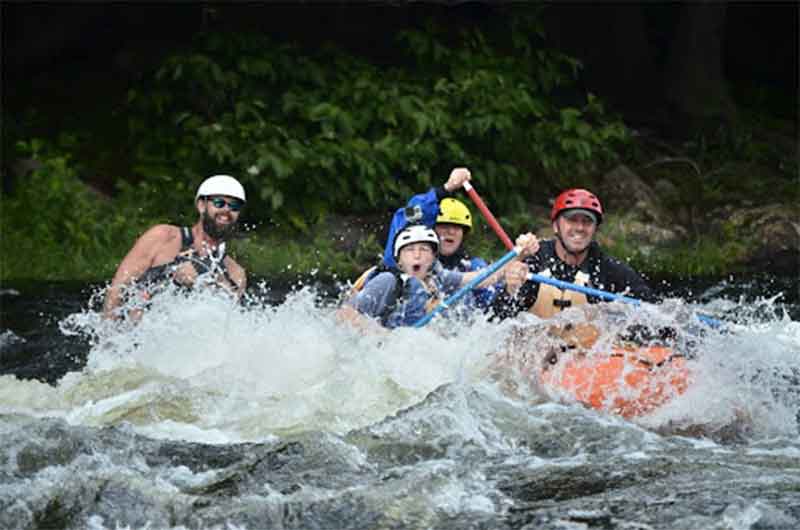
Rafting is one of those activities that combines adrenaline, teamwork, and nature’s beauty in a single unforgettable experience. But while most people focus on the thrill of conquering rapids, one of the most common questions beginners ask is simple yet crucial: what to wear for rafting?
Your clothing choice can make the difference between enjoying every splash and shiver or struggling with discomfort throughout the trip. Whether you are planning a beginner-friendly float or a challenging whitewater adventure, the right outfit is your first step toward safety and comfort.
In this guide, you will learn not only what to wear for rafting but also why these clothing choices matter. From footwear to protective gear, from seasonal variations to essential extras, this article covers it all.
Why Choosing the Right Outfit for Rafting Matters
Rafting isn’t like going for a casual swim or a beach holiday. The conditions can be unpredictable. Water temperatures are often colder than expected, even in summer. Rapids can be intense, and accidents like falling into the water or bumping against rocks are common.
According to wildcurrentrafting, wearing the wrong clothes can ruin the experience. Cotton, for example, takes forever to dry and makes you feel cold. Slippers can slip off and leave your feet exposed. On the other hand, proper rafting wear can keep you warm, protect your skin, and allow freedom of movement.
Your outfit is more than just comfort. It is about safety, performance, and maximizing your enjoyment on the water.
General Rules: What to Wear for Rafting
Before we break down clothing by season and situation, let’s establish a few universal rules. These apply no matter where or when you go rafting.
- Avoid cotton. It soaks up water and holds it, making you cold.
- Choose quick-drying, moisture-wicking fabrics like polyester or nylon.
- Prioritize layers. This allows you to adapt to changing temperatures.
- Wear snug but flexible clothing to ensure mobility.
- Always wear secure footwear with good grip.
- Don’t forget safety gear like a helmet and life jacket provided by operators.
With these basics in mind, let’s dive deeper into what to wear for rafting in different conditions.
Clothing for Warm Weather Rafting
When the sun is shining and temperatures are high, many people assume rafting is as simple as wearing a swimsuit. But in reality, it’s not that straightforward. Even in warm climates, rivers can be chilly, and the sun reflects strongly on the water.
Base Layer
A swimsuit or moisture-wicking shorts and top work well. If you prefer more coverage, a rash guard is a smart choice. It protects you from both the sun and minor scrapes if you fall in.
Top Layer
A light synthetic T-shirt or tank top can be worn over your swimsuit. Avoid cotton at all costs. Quick-drying fabrics are your best friend here.
Footwear
Wear water shoes, sandals with straps, or old sneakers with good traction. Flip-flops or loose sandals are dangerous because they can slip off and float away.
Accessories
Do not forget sunscreen, preferably waterproof and reef-safe. A hat with a strap or a buff can also help protect against sunburn. Sunglasses with a retainer strap will keep your eyes safe from glare.
Clothing for Cold Weather or Spring Rafting
Cold conditions demand extra attention to clothing. Rivers fed by snowmelt are icy even in spring and early summer. Without proper gear, hypothermia can become a risk.
Base Layer
Wear synthetic or wool base layers. These fabrics keep you warm even when wet. Avoid cotton completely.
Wetsuit or Dry Suit
For most cold-weather rafting trips, outfitters provide wetsuits or dry suits. A wetsuit traps a thin layer of water that warms up with your body heat. A dry suit, on the other hand, keeps you completely dry and is preferred for extreme cold.
Insulating Layer
If allowed under the wetsuit or dry suit, add fleece or wool for extra insulation.
Footwear
Neoprene booties or secure water shoes work best. Wool socks under booties can help in very cold water.
Accessories
Neoprene gloves keep hands warm and maintain your grip on the paddle. A thermal hat or helmet liner may also be useful in freezing conditions.
Safety Gear: Non-Negotiable Items
No matter the weather or your rafting skill level, certain gear is always necessary.
- Life jacket (PFD): This is always mandatory. Make sure it fits snugly.
- Helmet: Protects against rocks, paddles, and unexpected bumps.
- Footwear: Covered toes and firm grip reduce the risk of injury.
Most rafting companies provide helmets and life jackets. Still, ensure that you wear them properly and never take them off while on the water.
Accessories That Improve Your Rafting Experience
Small details often make a huge difference. Here are extras worth bringing.
- Sunglasses with strap: Protect your eyes from UV rays and glare.
- Waterproof sunscreen: Essential even on cloudy days.
- Dry bag: To keep your phone, snacks, or first aid kit safe.
- Towel and change of clothes: For after your trip.
- Reusable water bottle: Staying hydrated is as important as staying safe.
Common Mistakes to Avoid
When planning what to wear for rafting, beginners often make mistakes that lead to discomfort or risk.
One common error is wearing jeans or cotton T-shirts. These become heavy and cold when wet. Another mistake is choosing inappropriate footwear like flip-flops or Crocs. These either slip off or provide no protection against sharp rocks.
Jewelry and valuables are also best left behind. Anything that can fall off or rust should stay at home.
Finally, don’t underestimate the weather. Even in summer, rivers can be cold, and sun exposure is stronger on the water. Always prepare for conditions to change.
Seasonal Guide: What to Wear for Rafting Throughout the Year
Different seasons bring different challenges. Here is a quick breakdown.
Spring
Snowmelt makes rivers cold and fast. Wetsuits or dry suits are often necessary. Layering is crucial.
Summer
Warm weather but cold rivers. Swimsuits, rash guards, and quick-dry shorts work well. Sun protection is a priority.
Fall
Temperatures drop quickly, especially in the evenings. Layer with synthetic or wool materials, and consider wetsuits depending on the river.
Winter
Rafting in winter is less common but possible in some areas. Only attempt this with professional guides and full cold-water gear like dry suits.
Rafting Outfit for Kids
If you are planning a family rafting trip, kids need extra care when it comes to clothing. Children get cold more easily, so wetsuits are often recommended even in warmer conditions. Make sure their life jackets fit properly and are approved for their weight and size.
Kids should also wear closed-toe shoes with straps, as they can lose footwear more easily. Sun hats with chin straps, rash guards, and waterproof sunscreen are essential to protect their sensitive skin.
Rafting Outfit for Women
Women often have slightly different needs when deciding what to wear for rafting. Many prefer swimsuits with supportive straps to ensure comfort during active paddling. Sports bras made of quick-drying fabrics are more comfortable than regular bras.
For added coverage and sun protection, many women opt for leggings or lightweight water tights. Rash guards with UPF protection are also a practical choice.
Rafting Outfit for Men
For men, board shorts or swim trunks paired with a moisture-wicking T-shirt or rash guard work best in warm weather. In colder conditions, wetsuits or synthetic base layers are the safest options.
Avoid baggy shorts or anything with lots of pockets that can trap water. A snug but flexible fit ensures maximum comfort and safety on the raft.
Regional Considerations: What to Wear for Rafting Around the World
Not all rafting destinations are the same. In tropical countries like Costa Rica or Bali, you’ll likely wear lighter outfits and focus on sun protection. In colder regions like Colorado, British Columbia, or the Swiss Alps, thermal layers and wetsuits are the norm.
When booking a rafting trip, always ask your outfitter about expected water and air temperatures. This ensures you pack the right gear for that location.
Final Tips on What to Wear for Rafting
If there is one thing to remember, it’s that rafting requires clothing that balances comfort, safety, and adaptability. You want to be protected from both cold and sun while still being able to move freely.
Think in layers, choose synthetic or wool over cotton, and make sure your footwear is secure. Helmets and life jackets are non-negotiable. Accessories like sunglasses, sunscreen, and dry bags make the trip more enjoyable.
By preparing your outfit carefully, you set yourself up for a safe and memorable adventure on the water.
Conclusion
Rafting is as much about preparation as it is about adrenaline. Knowing what to wear for rafting ensures you stay safe, comfortable, and focused on enjoying the ride rather than battling the elements.
Dress smart, layer properly, and always prioritize safety. With the right outfit, the river becomes less intimidating and far more exciting.
So next time you ask yourself what to wear for rafting, remember this guide. Pack the right gear, trust your guide, and get ready for an unforgettable adventure on the rapids.




